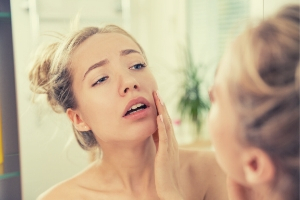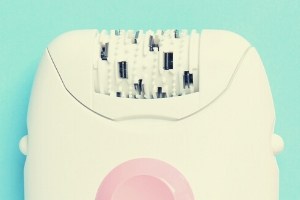After you’ve suffered through an epilation session, the last thing you probably want to do is focus on skin care. Unfortunately, not taking a few minutes on post-epilation skin care can result in unwanted side effects, including infection and ingrown hairs. This last step is always an important part of epilating, but most important when you are first starting out and not sure exactly how your body reacts to epilation.
After epilating, you need to prevent infection, soothe inflammation, and prevent ingrown hairs. There are many ways to go about this, so read on to get an overview so you can decide what’s best for you and your skin.
Prevent Infection After Using an Epilator
When you epilate, you are pulling hairs out by the root. This causes a minor injury in the hair follicle which makes the area at risk for infections for about 24-48 hours.
Since newly epilated skin is prone to infection, the first thing you need to do after epilation is minimize the chances of exposing your skin to bacteria or other germs that can cause infection.
Clean the Skin
Ideally, you should have cleaned your skin before you epilated. You should have also cleaned your epilator head well before you started epilating. This is probably the best way to prevent infection.
So if you skin is already clean after epilating, simply wipe any excess hairs from your skin with a clean towel and you’re good to go.
However, if you did not clean your skin before you started epilating, now is the time to do it. Gently cleanse the skin with a mild soap. Then pat dry the area with a clean towel.
If you don’t have access to a shower or sink to cleanse the area well (when traveling, for example), use a topical over the counter antiseptic spray or cleansers.
I love Bactine for this purpose. In fact, you may want to use Bactine before you epilate because it also contains lidocaine which help reduce the pain of epilating. If you decide to use a different antiseptic, I would avoid any with alcohol as this irritates and dries the skin. And your skin is already irritated at this point.
Keep the Skin Clean
Once you have clean skin, you need to keep it clean until the risk of infection has gone down. It’s super tempting to obsessively touch your smooth skin after epilating, but make sure you don’t touch your skin with dirty hands.
Since sweat can transport bacteria, try to avoid activities that cause excess sweating like working out for about 24 hours.
You should also make sure that you are only wearing fresh, clean clothing.
If by chance you do touch your skin or expose the epilated area to germs or bacteria, just cleanse the skin again and pay dry with a clean towel. Or use a topical antiseptic product.
Soothe Skin After Epilation
After using an epilator, you are likely to have some skin redness as well as some minor pain, swelling, or other signs of inflammation.
If you just have some mild redness, you don’t really need to do anything. This is perfectly normal and will go away on its own. However, if you are experiencing pain, swelling, a rash from histamine or another inflammatory response from the body, you can tap into many different hacks and resources to calm your skin and facilitate recovery.
Ice
A cold compress, bag of frozen vegetables, or a cold wet washcloth applied to the skin for up to 20 minutes will work well to reduce swelling, pain, and irritation.
Lidocaine
If you have lingering pain, Bactine or another topical product with lidocaine will help numb it. Bactine has the added benefit of being an antiseptic so helps prevent infection.
Loose Clothing
Tight clothing rubs against the skin and causes irritation. Wear loose clothing for 1-2 days after your epilate your hair.
Cortisone Cream
If you break out in histamine bumps, a rash, or have inflammation, an over-the-counter cortisone cream may help.
Avoid Harsh Products
For the first 24 hours after epilating, it’s best to avoid any harsh or drying products including perfumes, tanning products, deodorants, or alcohol containing products.
Aloe Vera Gel
Applying some aloe vera gel, either from a bottle like this product or straight from an aloe vera leaf, will soothe skin without causing breakouts. It also helps moisturize.
Sudocrem
Using some Sudocrem after epilating on your skin will reduce irritation. It also has the added benefit of antiseptic ingredients so will help prevent infection.
Your Pharmacist
An often untapped resource is your pharmacist. She can give you a custom recommendation for either topical or oral medications based upon your symptoms.
Prevent Ingrown Hairs After Epilation
A common side effect of epilation is ingrown hair. When hairs are pulled from the root, new hairs have to grow back in and find their way to the surface of the skin. If skin is dry or dead skin cells are clogging the hair follicle, hair can get stuck under the surface, resulting in ingrown hair.
Because of this, it’s important to take steps to minimize dry skin and the accumulation of dead skin cells after epilation.
Moisture After Epilating
To prevent dry skin, start moisturizing your skin within 24 hours of epilating. Some people break out if they moisturize too soon due to irritated pores and skin, so you may need to wait an hour or more before applying a moisturizer.
To prevent further irritation, it’s best to use a gentle moisturizer that is alcohol and fragrance free. If you are using it on acne-prone areas like the face, then it should be non comedogenic as well. An aloe vera gel works well for this purpose. Aloe vera not only helps reduce inflammation, but also moisturizes and exfoliates. And as always, make sure your hands are clean before applying the moisturizer to recently epilated skin.
Continue to moisturize your skin daily or as necessary to keep skin from drying out.
Exfoliate After Epilating
To eliminate dead skin cells, you should exfoliate your skin after about 2-3 days after using an epilator. This allows time for irritation to completely subside and gives pores time to heal and close up. You should continue to exfoliate every 2-3 days to prevent ingrown hairs.
There are two main ways to exfoliate your skin: using friction or a chemical product.
With friction, you simply need to slough dead skin cells off by rubbing skin with an exfoliation cloth, glove, loofa, or pumice stone. For better results, use an exfoliating scrub.
I like to mix brown sugar into coconut oil and add a few drops of lavender essential oil to create a low cost moisturizing exfoliation scrub, but there are endless make-for-you products available. One that many people swear by is Soap And Glory Flake Away Body Scrub.
Another option is to use a chemical exfoliation product such as Tendskin. These products contain acetylsalicylic acid or similar ingredients that help remove dead skin cells and free ingrown hairs without relying on friction.
After Epilating Cream
If you have been reading about epilation online, you may have encountered people talking about after epilation cream and are wondering what it does. So what is after epilation cream? After epilation cream is a cream, lotion, or other topical product that is made specifically to use after hair removal methods that remove hair by the roots, such as waxing or using an epilator.
These creams usually have ingredients that reduce waxing residue and calm skin. Some also have antiseptic properties to help prevent infection. And some have ingredients intended to slow hair growth.
Two of the most popular after epilation creams are GiGi Post Epilation Lotion and Parissa Azulene After Waxing Oil.
Is After Epilation Cream Worth the Money?
Unless you are interested in a growth inhibitor to slow hair growth after epilation, I don’t think that after epilation creams are usually necessary. For one, you are usually paying a premium to have a product that does multiple things at once, but you probably don’t need all these ingredients. Since you aren’t waxing, you definitely don’t need to remove wax residue.
I think you may have better luck using lower cost products that address specific issues you have after epilation. For example, if you have histamine bumps, a cheap tub of cortisone cream works great.
Final Takeaways
This post has listed the best practices for after epilation care so that you end up with the best results with the fewest side effects possible. After epilation, you need to take steps to prevent infection, soothe skin, and then prevent ingrown hairs.
All of the after-care steps listed above may seem overwhelming, but here’s a little secret: I do almost none of these on a regular basis and still have few epilator side effects.
For example, I often epilate my underarms before taking a shower, with a dirty epilator head, and then only use a loofa and regular soap to cleanse/exfoliate afterward. Then I put on deodorant immediately and sweat like a pig. Yep. I suck at after epilation care.
Yet I only get mild redness on my underarms. No major inflammation, no pimples, no infections, no ingrown hairs. However, I couldn’t do the same on my legs all the time and get the same results. Your mileage may very and every area of your body will be different.
It’s definitely best to start with all the steps I’ve listed in this post until you get used to epilating and know how your body reacts. Then adjust your practices as time goes on. And keep in mind that if you don’t do everything perfectly, it’s probably not going to be the end of the world.
Related Questions
Should I use coconut oil after epilating?
Coconut oil is considered comedogenic so it can cause pimples. If you’re not prone to acne or have dry skin, then it’s usually fine to use coconut oil as a moisturizer after epilation. However, if you want a natural alternative, I recommend jojoba oil because it’s non comedogenic and it doesn’t go rancid like coconut oil does.
Can I use deodorant after epilating?
After epilating, it’s best to wait until irritation subsides or about 12 -24 hours before using deodorant. This will prevent irritated skin and avoid introducing bacteria from your deodorant stick. It’s usually easiest to just epilate your armpits at night so you don’t need deodorant right away.
What’s the best lotion for after epilation?
Immediately after epilation, I recommend aloe vera gel to soothe and moisturize the skin. Two other good options include jojoba oil and Sudocrem.
Have more questions about epilation? Check out the Epilator FAQ and Beginner’s Guide!
Want to remember this? Pin this to your favorite Pinterest board so you can find it later!

References:
Indian Journal of Dermatology: Aloe Vera: A Short Review
U.S. Food and Drug Administration: Safety and Effectiveness of Health Care Antiseptics








